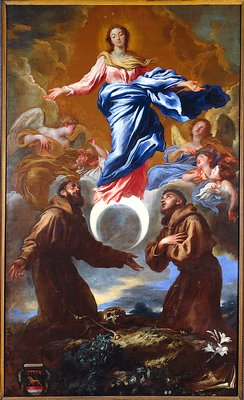Tota pulchra es, Maria, et macula originalis non est in te

The Catholic Church, and all Her faithful, owe a particular debt to the Franciscans. It was this "seraphic order," as Dom Guéranger called them, that propagated and defended the teaching that the Blessed Mother of Our Lord and Saviour Jesus Christ was preserved from original sin from the first moment of her life. This ministry of theirs started with their founder, St. Francis of Assisi (I will write on St. Francis' defense of this doctrine later).
"[It is] unjust to pass over the immense share which... the Order of St. Francis of Assisi, has had in the earthly triumph of our blessed Mother, the Queen of heaven and earth. As often as this feast [of the Immaculate Conception] comes round, is it not just that we should think with reverence and gratitude on him, who was the first theologian that showed how closely connected with the divine mystery of the Incarnation is this dogma of the Immaculate Conception? First, then, all honour to the name of the pious and learned [Blessed] John Duns Scotus!" [from Dom Guéranger's entry in "The Liturgical Year" for December 8th, "The Immaculate Conception"]
Blessed Duns Scotus
The Franciscan Friars of the Immaculate wrote a short biography of Blessed John, in which is mentioned an occasion when the Immaculate Conception herself appeared to the theologian. "During the night of Christmas, 1299 at the Oxford Convent... [t]he Blessed Mother appeared to him and placed on his arms the Child Jesus who kissed and embraced him fondly. This was perhaps the occasion which inspired Bl. John to write so profoundly and fluently on the absolute primacy of Christ and the reason for the Incarnation."
Of course, my entry on these important contributions of Franciscans to the history of the devotion to the Immaculate Conception wouldn't be complete without mentioning one of my spiritual fathers, St. Maximilian Mary Kolbe, who founded the Militia Immaculatae (which I joined more than 2 years ago, on the occasion of my total consecration to Jesus through the Immaculate Heart of Mary). It was he who wrote:
"The Immaculate One appears in this world without the least stain of sin, the masterpiece of God's hands, full of grace. God, the Most Holy Trinity, beholds the lowliness (that is, the humility, the root of all Her other virtues) of His Handmaid, and does great things for Her, He the Almighty (cfr. Lk. 1,49). God the Father gives Her His own Son to be Her Son; God the Son descends into Her womb; and God the Holy Spirit forms the body of Christ in the womb of this pure Virgin. And the Word was made flesh (Jn. 1,14). The Immaculate One becomes the Mother of God. The fruit of the love of God in his Trinitarian life and of Mary the Immaculate One is Christ the God-Man."
St. Maximilian also made an excellent point about our relationship with the Blessed Virgin Mary, who is our Queen and our Mother. He wrote, "True knowledge of the Immaculate One can only be acquired in prayer. The purer a soul is, the greater efforts it makes to avoid sin; and if it does happen to sin, it tries its best to rise from sin and to make up for its fault by love. The more humble it is, and the more spirit of penance it shows, the more and better it will get to know the Immaculate" (both quotes of St. Maximilian Kolbe are taken from Excerpts from the Writings of St. Maximilian).
Let us pray, then, as she taught us to pray at Rue de Bac: "O Mary, conceived without sin, pray for us, who have recourse to thee!"
[Special thanks to AnAmericanMother of Free Republic.com for posting the above painting of Our Lady on a FR thread. It was painted by Giovanni Benedetto Castiglione in 1649-1650. It shows St. Francis of Assisi and St. Anthony of Padua venerating the Immaculate Conception, who is portrayed as the Woman from Revelation, chapter 12. What I find interesting about the painting is that she is shown with these two Franciscan saints, who tried to convert the Muslims to Christianity. Of course, the symbol for this "faith" is the crescent moon, and look who's standing atop such a moon in the painting! When I first saw this painting, I thought of the liturgical text that says that Our Lady will crush all heresies (Gaude Maria Virgo, cunctas haereses sola interemisti), and certainly, Islam is the biggest such "heresy" in the world at the moment! You can read about this painting at Restoring a Masterwork.]


1 Comments:
I really liked your blog posting today. Very insightful and informative. :)
Post a Comment
<< Home